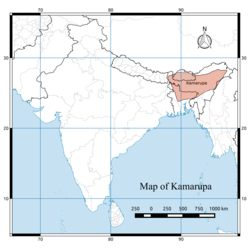Mlechchha dynasty
Kamarupa Kingdom Mlechchha dynasty | |||||||||
|---|---|---|---|---|---|---|---|---|---|
| 650 CE–900 CE | |||||||||
 Kamarupa Map | |||||||||
| Capital | Harruppesvar (present-day Tezpur) | ||||||||
| Religion | Shaktism, Polytheism | ||||||||
| Government | Monarchy | ||||||||
| Maharajadhiraja | |||||||||
• c. 650 - c. 670 | Salasthamba | ||||||||
• c. 815 – c. 832 | Harjjaravarman | ||||||||
• c. 890 – c. 900 | Tyagasimha | ||||||||
| Historical era | Classical India | ||||||||
• Established | 650 CE | ||||||||
• Disestablished | 900 CE | ||||||||
| |||||||||
| Part of a series on the |
| History of Kamarupa |
|---|
 |
| Ruling dynasties |
| Part of a series on the |
| History of Assam |
|---|
 |
| Categories |

The Mlechchha dynasty (c. 650 - 900) ruled Kamarupa from their capital at Harruppesvar in present-day Tezpur, Assam, after the fall of the Varman dynasty.[2] According to historical records, there were twenty one rulers in this dynasty, but the line is obscure and names of some intervening rulers are not known.[3] Like all other Kamarupa dynasties a semi-mythical lineage from Narakasura was constructed to accord legitimacy to their rule.[4] The Mlechchha dynasty in Kamarupa was followed by the Pala kings. The dynasty is unrelated to the previous Varman dynasty.[5]
Sources
Salasthambha is first mentioned in an inscription 175 years into the rule of the dynasty.[6]
The Hayunthal Copper Plates, dated to the middle of 9th Century CE, mentions multiple kings from the dynasty in a chronological fashion — Salastamba, Vijaya, Palaka, Kumara, Vajradeva, Harsavarman, Balavarman, [unnamed], Harjaravarman, and Vanamala.[7] The Tejpur Copper Plates (since lost), roughly dated to the same spans, primarily chronicles Vanamala — other rulers like Pralambha, and Harjaravarman are mentioned.[7] The Parbatiya Copper Plates, again roughly dated to the middle of 9th Century CE, chronicles Vanamala.[7]
Origins and etymology
It is not clear how Salasthambha, the first of this dynasty, came to power.[8]
According to some historians, the remnant of the Mlechchha kingdom formed the later
Rulers
The grants of Ratnapala give the list of 21 kings from Salastambha to his line.[3]
- Salastamba (650-670)
- Vijaya alias Vigrahastambha
- Palaka
- Kumara
- Vajradeva
- Harshadeva alias Harshavarman (725-745)
- Balavarman II
- Jivaraja
- Digleswaravarman
- Pralambha[14]
- Harjjaravarman (815-832)
- Vanamalavarmadeva (832-855)
- Jayamala alias Virabahu (855-860)
- Balavarman III (860-880)
- Tyagasimha (890-900)
References
- ^ (Shin 2010:8):"Along with the inscriptional and literary evidence, the archaeological remains of the Kamakhya temple, which stands on top of the Nilacala, testify that the Mlecchas gave a significant impetus to construct or reconstruct the Kamakhya temple."
- ^ (Sen 1999:P.304)
- ^ a b (Ray 1931:242)
- ^ Shin 2011, p. 183.
- ^ (Shin 2016:127):"From a close reading of the royal genealogy, it is apparent that there was no unilineal development of dynasties and definite connection among them. In fact, the Mlecchas and the Pālas denied the validity of previous dynasty for claiming their own legitimacy and the character and identity of progenitor, Naraka, were continuously re-formulated according to the socio-political changes."
- ^ (Sircar 1990:125)
- ^ a b c d Sharma 1978, pp. 89, 93.
- ^ "(W)hen exactly Salasthambha occupied (the throne of Kamarupa) and under what circumstances cannot be determined in the present state of insufficient information." (Sircar 1990:122)
- ^ (Chatterji 1951:97)The distinct mention of Sala-stambha as being a lord of the Mlecchas, as in the Bargaon copper-plate of the 19th century, would appear to make it clear that he was a Bodo chief of the Mèch tribe (Sanskritised as Mlēccha), who followed Bhaskara-varman in assuming the rulership of Assam
- ^ (Shin 2011:178) According to D.C. Sircar, 'Mleccha' may be sanskritized form of tribal name 'mech'
- ^ "Salasthambha is called mlecchādhinath or lord of the Mlecchas in Ratnapalal's grant of the first half of the 10th century." (Sircar 1990:124)
- ^ Sharma 1978, p. 35.
- ^ (Bhattacharjee 1992:393)
- ^ Pralambha, read from the Tezpur plates, can be corrected to Salambha, in light of the Parbatiya plates, (Sarma 1978, p. 105)
Bibliography
- Saikia, Yasmin (2004). Fragmented Memories: Struggling to be Tai-Ahom in India. Duke University Press. ISBN 9780822333739.
- Shin, Jae-Eun (2018), "Region Formed and Imagined: Reconsidering temporal, spatial and social context of Kamarupa", in Dzüvichü, Lipokmar; Baruah, Manjeet (eds.), Modern Practices in North East India: History, Culture, Representation, London & New York: Routledge, pp. 23–55
- Urban, Hugh (2009), The Power of Tantra: Religion, Sexuality and the Politics of South Asian Studies, Bloomsbury Publishing, ISBN 9780857715869
- Shin, Jae-Eun (2010). "Yoni, Yoginis and Mahavidyas : Feminine Divinities from Early Medieval Kamarupa to Medieval Koch Behar". Studies in History. 26 (1): 1–29. S2CID 155252564.
- Nath, D. (1989). History of the Koch Kingdom, C. 1515-1615. Mittal Publications. ISBN 9788170991090.
- Baruah, S L (1986), A Comprehensive History of Assam (book), New Delhi: Munshiram Manoharlal Publishers
- Ray, H.C. (1931). Dynastic History Of Northern India Vol. 1. New Delhi: Munshiram Manoharlal Publishers.
- Bhattacharjee, J. B. (1992), "The Kachari state formation", in Barpujari, H. K. (ed.), The Comprehensive History of Assam, vol. 2, Guwahati: Assam Publication Board, pp. 391–397
- Sharma, M M (1978), Inscriptions of Ancient Assam, Guwahati: Gauhati University
- Sircar, D. C. (1990), "The Mlechchha Dynasty of Salasthambha", in Barpujari, H. K. (ed.), The Comprehensive History of Assam, vol. 1, Guwahati: Assam Publication Board
- Chatterji, S.K (1951). Kirata-Jana-Krti. Calcutta: The Asiatic Society.
- Shin, Jae Eun (2011). "Changing Dynasties, Enduring Genealogy: A Critical Study on the Political Legitimation in Early Medieval Kāmarūpa". Journal of Ancient Indian History. 27: 173–187.
- Sen, S.N. (1999). Ancient Indian History and Civilization. New Age International. ISBN 9788122411980.
- Shin, Jae Eun (2016). "Searching for Kāmarūpa:Historiography of the Early Brahmaputra Valley in the Colonial and Post Colonial Period". Journal of the Directorate of Archaeology and Museums, Government of West Bengal. 1: 115–32.
